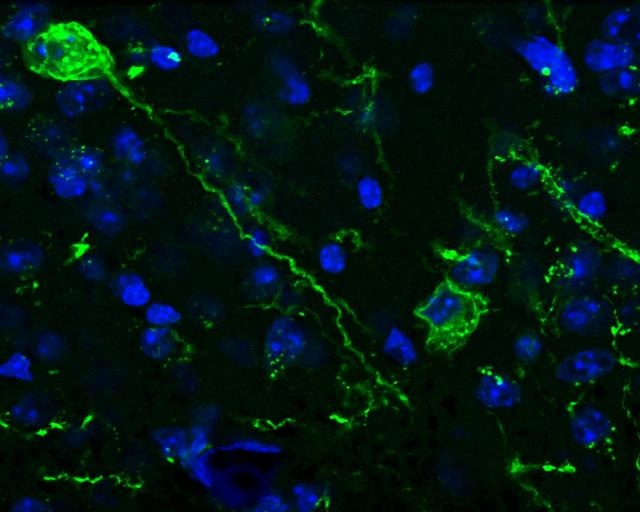Jun 2 2016
Raül Andero Galí, a researcher at Harvard University and one of the heads of the "Neurobiology of Stress and Addiction" research team at the Institut de Neurociències (INc) of the Universitat Autònoma de Barcelona (UAB), published a research paper in which memory was increased using optogenetics. This is the first time light stimulation has been utilized to boost memory.
 This image shows microphotography of the cerebral amygdala. Tac2 neurons, involved in the memory of fear, are marked in green. In blue, the nucleus of amygdala neurons. (Credit- INc-UAB)
This image shows microphotography of the cerebral amygdala. Tac2 neurons, involved in the memory of fear, are marked in green. In blue, the nucleus of amygdala neurons. (Credit- INc-UAB)
A group of neurons in the cerebral amygdala called Tac2 are stimulated by a laser while testing the technique in mice. Before laser stimulation, these neurons should be made susceptible to light by administrating a virus in a certain cerebral area. The neurons in that area are required to store fear-related memories. It was observed that the mice that underwent the treatment had increased long-term memory, and remembered danger in a better way.
Light stimulation has been used for the first time to activate certain group of memory neurons. In earlier studies, various other memory neurons were stimulated. This study sheds light on the mechanism of fear learning and brings us one step closer to find treatments for diseases related to fear. This study has been reported in Neuropsychoparhamacology (Nature) journal.
Our discovery stresses the importance of Tac2 neurons in the regulation of fear, and opens the door to new therapeutical targets for the treatment of diseases related to fear such as phobias, obsessive-compulsive disorder and post-traumatic stress disorder. Moreover, it can also help to find new ways to improve the memory of healthy people or people with memory problems.
Raül Andero Galí, Researcher, Harvard University
Scientists monitored the behavior of two populations of mice to arrive at the these conclusions. There was one set of mice without treatment and the other under optogenetics treatment. Both sets were exposed to a tone following which they were subjected to unpleasant electrical stimuli. The mice that were subjected to optogenetics were able to recall that the tone preceded the stimuli for a longer period of time and even displayed signs of fear on hearing the tone after many days.
Raul Andero's study was carried out for over two years at Kerry Ressler's lab in McLean Hospital, Harvard University and was finally concluded in UAB. The published study is the result of this work. A couple of years back, a drug that alters this kind of memory was patented by Andero and Ressler. Other analogs, including this drug, could reduce the emotional effects of traumatic events in the future and also reduce the risk of mental disorder associated with trauma.
Andero and his colleagues would pursue studying the cerebral mechanisms of fear learning in their future research.
Next steps will be to study, by optogenetics, how the amygdala communicates with other parts of the brain also related to fear learning.
Raül Andero Galí, Researcher, Harvard University
Thanks to the expertise gained through this method, the UAB's Institut de Neurociències is positioned as a leading center in the country and paves the way for multiple international associations.